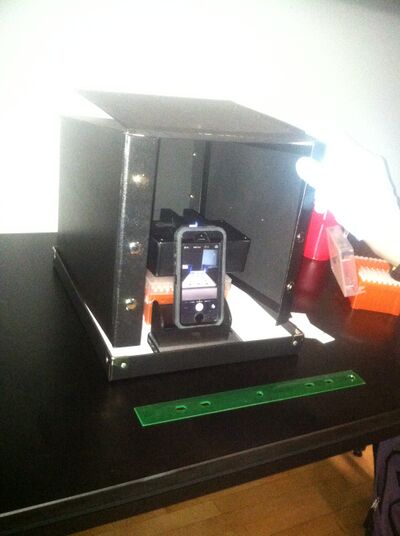BME100 f2014:Group24 L5
| Home People Lab Write-Up 1 | Lab Write-Up 2 | Lab Write-Up 3 Lab Write-Up 4 | Lab Write-Up 5 | Lab Write-Up 6 Course Logistics For Instructors Photos Wiki Editing Help | |||||||
|
Our Team
ProceduresCamera Settings:
Calibration
Distance between camera and drop: 6.5 cm
Solutions Used for Calibration: Procedure for Placing Samples onto the Fluorimeter:
Data AnalysisSNP Info & Primer DesignBackground: An SNP is a single nucleotide polymorphism. SNPs are common DNA sequence variations in which a single nucleotide is different between two members of a biological species. These genetic variations between individuals can result in changes in the phenotypes of individuals. In addition, SNPs also affect how people develop diseases and how they react to medicine. Studying SNPs is important for comparing certain parts of dna with diseases and without diseases.
Lab DPCR LAB D What is a nucleotide? It is the basic building block of DNA What is a polymorphism? a common variation of DNA among individuals. What species is this variation found in? Homo Sapiens What chromosome is this variation found on? 21:34370656 What is listed as the Clinical Significance of this SNP? pathogenic What gene is this SNP associated with? KCNW2 What diesease is linked to this SNP? Congentital Long QT syndrome What does KCNE2 stand for? potassium voltage-gated channel Describe the molecular function of this gene: This gene encodes a member of the potassium channel. This member is a small integral membrane subunit that assembles with the KCNH2 gene product, a pore-forming protein, to alter its function. This gene is expressed in heart and muscle. What is an allele? An allele is an alternative form of a gene that is located at a specific position on a specific chromosome. The disease-associated allele contains what sequence? CTC The numerical position of the SNP is: 34370656 Non-disease forward primer (20nt): CAT GGT GAT GAT TGG AAT GT The numerical position exactly 200 bases to the right of the disease SNP is 34370856 Non disease reverse primer: CCC TTA TCA GGG GGA CAT TTT Disease forward primer: CAT GGT GAT GAT TGG AAT GC Disease reverse primer (20nt): CCC TTA TCA GGG GGA CAT TT |
|||||||









